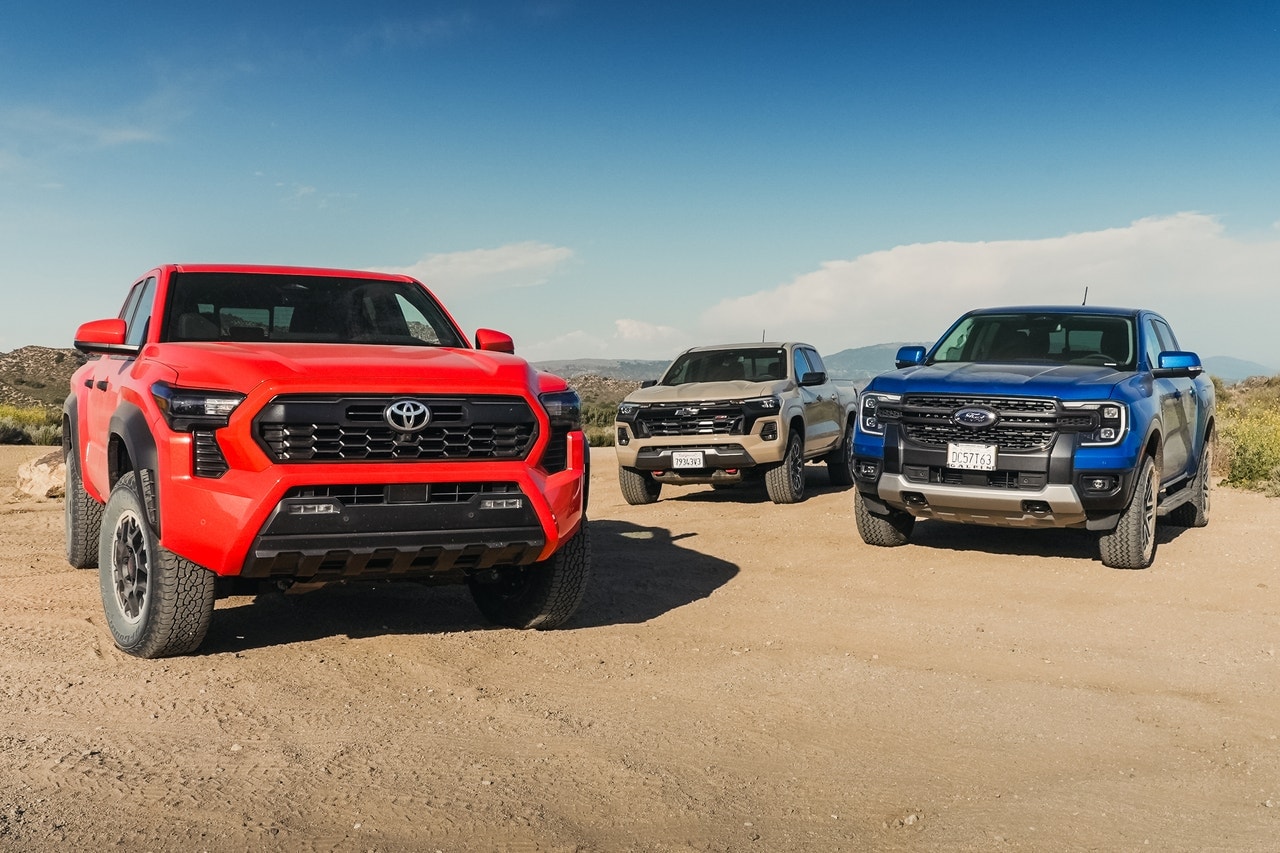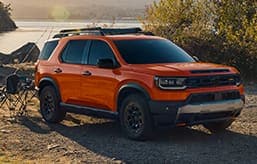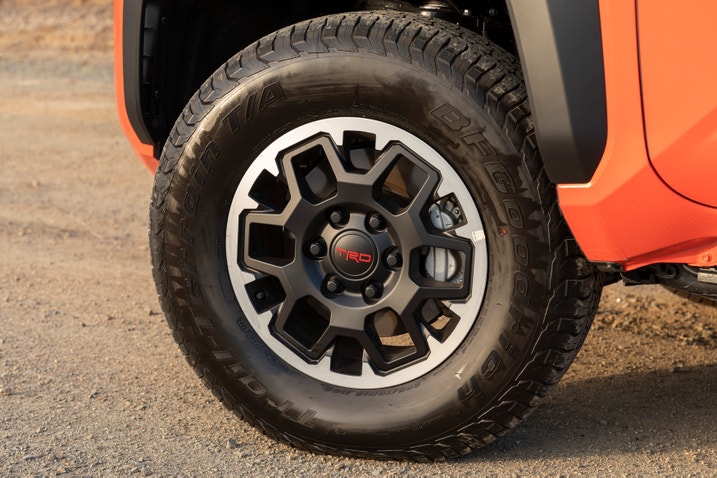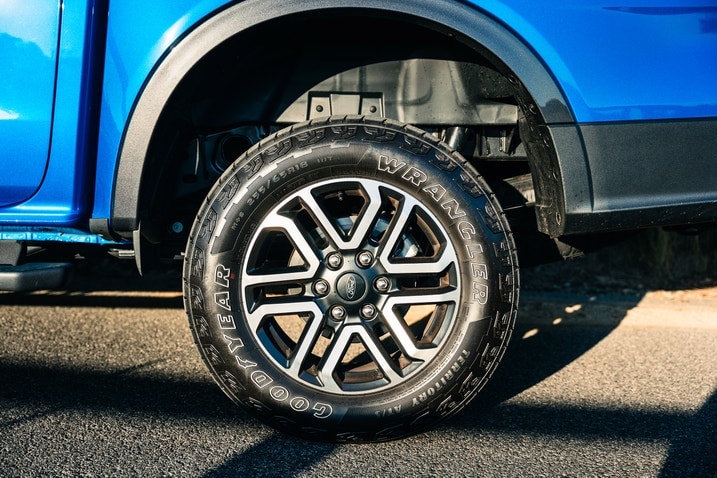- Chevrolet, Ford and Toyota offer some extremely capable ZR2, Raptor and TRD Pro trucks.
- But we want to see how the less expensive Colorado Z71, Ranger FX4 and Tacoma TRD Off-Road fare in the dirt.
- All three of these trucks are part of Edmunds' long-term test fleet.
Chevy Colorado Z71 vs. Ford Ranger FX4 vs. Toyota Tacoma TRD Off-Road: Tread Lightly
We test the off-road capabilities of these not-so-hardcore trucks
The Chevy Colorado ZR2, Ford Ranger Raptor and Toyota Tacoma TRD Pro are some of the best off-road trucks on sale today. But they're also pretty stinkin' expensive. What if you want to hit the trails without breaking the bank?
That's where these trucks' lesser off-road grades come in. The Colorado Z71, Ranger FX4 and Tacoma TRD Off-Road certainly look like capable dirt-slingers, but how good are they, really, when the going gets tough? That's what we aim to find out.
Three of a kind
Incidentally, all three of these trucks are part of Edmunds' long-term test fleet; we've had the Colorado for several months, but the Ranger and Tacoma are relative newcomers to our garage. All three have turbocharged four-cylinder engines, automatic transmissions and four-wheel drive.
Chevy only sells the Colorado with a 2.7-liter turbocharged four-cylinder engine, but offers this powertrain with three states of tune. Our truck has the most powerful TurboMax spec: 310 horsepower and 430 lb-ft of torque. Our truck also has 18-inch wheels, 32-inch Goodyear Wrangler all-terrain tires, an automatic rear locking differential (more on that shortly), and a two-speed transfer case for the four-wheel drive system. All told, we paid $48,445 for our Colorado when we purchased it for our long-term fleet last year.
Ford will soon offer the Ranger with an upgraded 2.7-liter turbo-four, but it wasn't available when we bought ours. Instead, our truck has the smaller 2.3-liter turbocharged engine, making 270 hp and 310 lb-ft of torque. The FX4 Off-Road package gets us things like all-terrain tires, an electronic locking rear diff, and an upgraded suspension. Price as tested? $50,580. Not a huge upcharge over the Colorado, and frankly, you get what you pay for inside. The Ranger's interior is so much nicer than the Chevy's.
Last, but certainly not least, is our 2024 Toyota Tacoma TRD Off-Road. Its 2.4-liter turbocharged inline-four makes more power than the Ranger's engine (278 hp, 317 lb-ft), but it's also more expensive, at $55,240. Toyota now sells the Tacoma with an optional i-Force Max hybrid powertrain, but we didn't want to wait for that when we ordered our truck. Our bright orange TRD Off-Road has all-terrain tires, a locking rear diff, crawl control (think of it as a low-speed cruise control), and something the other trucks don't have: a disconnecting stabilizer bar. You'll see why this comes in handy in a moment.
The ziggurat
We had to remove our Colorado's ridiculous air dam to even attempt the ziggurat — a series of concrete steps that test suspension travel and wheel articulation. The Colorado made it about halfway up the steps, and we wouldn't have gone any farther. That bash plate? Yeah, it's plastic. The other trucks have steel.
The Ford Ranger did marginally worse than the Colorado, stopping just short of where the Chevy landed. But the Tacoma? It went three-quarters of the way up the ziggurat, largely thanks to the extra flexibility afforded by its disconnecting sway bar. That's a $1,000 option you'll definitely want to check should you plan to do some rock crawling in your midsize truck.
Climbing hills and crawling over pipes
Our off-road hill-climb test is no joke. Remember our long-term Chevy Tahoe Z71? It couldn't even make it 15 feet up the hill. The Colorado is much better suited to this sort of task, and the low-range four-wheel-drive system lets us make great use of the engine's 430 lb-ft of torque. There's plenty of power for low-speed crawling. We just wish we had manual control over the locking rear differential. The Colorado has to wait until it detects some slippage before it'll automatically lock the rear. If we could just set this from the get-go, we wouldn't spin a tire in the dirt.
The Ranger might be down on power compared to the Colorado, but once we select low-range four-wheel drive and lock the rear differential, the Ford has no problem crawling up the hill. Would it be easier with the more powerful 2.7-liter engine? Probably. But it's good to know the 2.3-liter engine has enough oomph for the job. We just wish the rear locker button wasn't in the touchscreen. Something like that should be on the center console.
Now, the Tacoma has a small advantage: Its all-terrain tires are a little better than what the Colorado and Ranger offer. This means we could get farther up the hill before having to switch to low-range four-wheel drive. That said, Toyota's brake-based traction control system is super helpful here. We made it all the way up the hill climb without needing to use the rear differential locker or sway bar disconnect. That's impressive.
On the pipe/rock obstacle course, all three trucks had no problem completing the task in low-range four-wheel drive with the rear differentials locked. The Ranger's forward-facing camera helps the most; Toyota's grainy camera isn't helpful at all. If you don't have a spotter on hand who can help guide you, the Colorado or Ranger is the best.
But this section points out a weakness of all three pickups: ground clearance. Sure, there's plenty for day-to-day tasks, but compared to the more robust ZR2s, Raptors and TRD Pros of the world, these trucks sit lower to the ground, meaning you'll bash your skid plates a lot more often. (Ask us how we know.)
High-speed fun
Now, when it comes to high-speed shenanigans, you're absolutely going to want something like a Ranger Raptor or Colorado ZR2. Those trucks are built for that kind of thing. These lighter-duty models? Not so much.
Case in point: the Tacoma. On a high-speed sand course, this truck takes a lot of effort to keep it controlled. You need to use left-foot braking so you can keep your foot in the throttle and keep the turbocharger spooled up, and the Tacoma is not a fan of this driving style. It's not a fan of washboard surfaces either.
The Ranger, meanwhile, lets things get a little more playful in its Sand mode. You can easily left-foot brake, though this truck tends to default to understeer on loose surfaces, with big bouts of oversteer coming out of a corner if you aren't careful. It's better than the Tacoma in this test, for sure, but still not quite as sure-footed as we'd like.
The Colorado handily wins this portion of the test. It's got the most torque, its turbocharged engine is the most responsive, and generally speaking, it's the most fun. And really, that's what high-speed sand-blasting is all about: fun. You want a truck that happily plays along, not one that takes a lot of work to get loose.
A clear winner? Depends on what you want
The Toyota Tacoma TRD Off-Road won in two of our four sections: the hill climb and the ziggurat. But the Ranger bests it in the low-speed crawling section and the Colorado is simply more fun.
One thing to consider is the savings you get on these trucks compared to their more hardcore off-road rivals. The TRD Off-Road is a whopping $20,000 less expensive than a TRD Pro. The Ranger FX4 Lariat is roughly $5,000 cheaper than a Raptor, and if you don't need all the creature comforts, you can get an FX4 XLT for $13,000 less than a Raptor. The Colorado Z71 is priced the closest to its next-level-up sibling, with about a $6,000 difference between it and the ZR2.
So, which truck is our favorite? For going fast in the sand, it's the Colorado. For climbing hills, it's the Tacoma. And for the technical crawling, it's Ranger all the way. But because no one truck stands above the rest, it's hard to pick a clear winner.
Of course, these off-road midsizers still have a year of testing ahead of 'em. Stay tuned to see how our minds change after 20,000-plus miles of hard-wearing long-term use.
Emme Hall contributed to this story.










 by
by  edited by
edited by